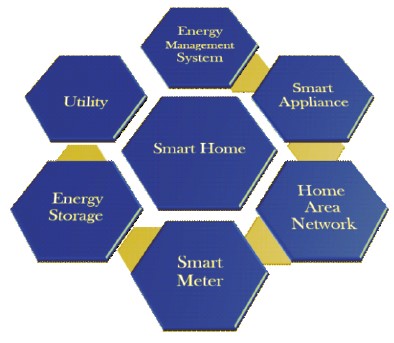
Figure 1. Elements of Smart Home
Energy management in home is gaining more attention as people try to use sustainable energy sources. This attempt to improve the use of infrastructure for energy production and distribution is expected to include smart grid systems. The incorporation of Internet of Things (IoT)-enabled smart devices into an ecosystem designed for maximum energy efficiency has been proposed for Smart Home Energy Management Systems (SHEMS). Smart homes are expensive, but smart plugs can change normal home devices relatively smart. This paper proposes a prototype design for a SHEMS it monitors and controls the energy consumption of smart devices to reduce the electricity bill and also detect energy theft.
The Internet of Things (IoT) is a network of physical objects or "things" equipped with sensors, software, and other technologies to communicate and exchange data with other systems and devices over the Internet. These devices range from common household items to hightech industrial tools. There are more than 7 billion IoT devices connected to the network, experts expect this number to rise to 10 billion by 2020 and 22 billion by 2025 (Oracle, 2022).
A smart home is equipped with newly developed advanced automation technology that gives its occupants intelligent monitoring and control over the functions of the home. A well-designed structure with adequate access to resources, communications, controls, data, and information technology is called a "smart home" (Oracle, 2022). Smart homes are expensive. Smart technologies can improve the quality of life in an ordinary home without spending a lot of money. Smart plugs enable smart home integration. It acts as an intermediary between the device and the power supply. Smart energy meters are used in smart homes to measure energy consumption. Electricity consumption has recently become evident in all areas. Modern technology has made a wide range of electrical equipment and appliances available ever ywhere, requiring the development of new strategies for regulating and tracking energy use. The electricity demand is steadily growing and is used for a variety of purposes, including agriculture, industry, domestic needs, hospitals, etc. Therefore, managing electricity maintenance and electricity demand is becoming more difficult. Therefore, it is essential to save as much energy as possible. The need for technology development is growing along with the demand for electricity from the newer generation of people.
Energy monitoring systems are one of the most important requirements for customers to reduce energy costs. A smart energy management system keeps track of how much energy is used. It calculates the daily energy consumption, which can help users find any errors in electricity billing. It can also help the user to analyze and manage device-level energy consumption data and help the user to switch from standard appliances to energy-efficient models. It is important to note that the monitoring system can notify the user of unexpectedly high consumption as a result of equipment failure or improper maintenance. In addition, efficient budgeting can be made possible through effective energy management.
Smart Home Energy Management System (SHEMS) has been used to monitor, regulate, and optimize energy flow and use (Asare-Bediako et al., 2012). SHEMS finds wide applications in power generation, transmission, and distribution systems. Supervisory control and data acquisition with energy management system capabilities are important applications. SHEMS is a recent major development for residential consumers. The desire for a more reliable and intelligent SHEMS is further motivated by solutions that are available to the network operator, such as demand response, demand-side control, peak smoothing, and load switching.
Morganti et al. (2009) proposed a smart home energy design and management method based on a new interface theory based on power distribution simulation, which contributed to more accurate energy supply data obtained from PV cells, storage, etc. The ability of the algorithm to optimize load scheduling and energy management was considered at the local level.
A human-centric Home Energy Management (HEM) system is to implement a butler-level mechanism. Based on this structure, the HEM system offers an intelligent device to meet the user's needs, aiming to reduce electricity cost and load and anticipate user stress. Smart home systems include smart grid strategies, making it difficult for users to effectively manage each strategy. In this proposed system, a human-centered smart home is built based on human behavior, user weight assessment, preferred usage practices, and the most efficient implementation of smart home energy plans. Based on a human-centric framework, the HEM system can be comprehensive enough to respond to various response request signals and make a costly contribution to programming and delivering results at all utility levels.
Wood and Newborough (2003) focus on the electronic feedback provided by smart meters. To improve the design and evaluation of the energy meter, it needs to receive feedback at regular intervals.
Corno and Razzak (2012) proposed a method for resolving intelligent energy management between customer needs and energy savings. It was based on accurate, advanced customer intent modeling and automatic device control.
Veleva et al. (2011) showed an innovative smart platform for a home energy management system that combines information from different physical sensors with information from active sensors and actuators to control different consumer devices at home.
Hamed (2012) proposed a home security guard in real life. The proposed approach demonstrated the hardware implementation of a multiplatform home automation control system based on the Laboratory Virtual Instrument Engineering Workbench (LabVIEW). Testing of the system has shown that it can certainly be used for applications including smart home automation.
Gottwalt et al. (2011) investigated the impact of smart gadgets and flexible tariffs on home electricity bills. This study showed that home smart device reserves were generally correlated with required investments.
Son et al. (2010) presented a power line communicationbased home energy management system. Smart metering and connection to power lines allow household gadgets to receive complete data on energy consumption patterns and intelligent control. The proposed approach has made it easier to use real-time energy consumption statistics for homes and to intelligently plan for home device management.
A Smart Home Energy Management System (SHEMS) is a combination of hardware and software that allows the user to keep track of how much energy is being used and how much is being produced. It also allows the user to control or automate the use of energy at home. As part of a network architecture, Advanced Metering Infrastructure (AMI) devices have created a reliable way to communicate between energy utilities and customers. This communication channel allowed economic incentives for smart homes to manage demand-side resources by switching energy consumption during peakload hours to reduce electricity bills. The interactive relationship between grid operators, utilities, and users makes all emerging Smart Grid technologies work together.
The main goal of SHEMS is to help people to track and control how much energy they use, or use energy more efficiently. To do this, the consumer needs to know how much energy is used in the home. This can only be found by tracking how much energy is being used throughout the home. Figure 1 shows the most elements of a smart home.

Figure 1. Elements of Smart Home
Smart Home Energy Management System (SHEMS) is divided into the following five components.
2.2.1 Measuring Device
SHEMS cannot function without measuring devices. The most common types of residential meters are gas, water, and electricity meters. The advanced measurement infrastructure has made it possible to measure information detail in real-time and collect and transmit data more frequently and in more places.
2.2.2 Sensing Device
Home sensors that can be used with SHEMS can measure current, voltage, temperature, motion, light, and occupancy. Other sensors, such as smoke and epilepsy sensors, are specifically designed for health, safety, and security. The desired parameters are in different places and send the information to the central system. With these settings, smart devices can be controlled, monitored, or set to start at specific times.
2.2.3 Enabling ICT
Information and Communication Technology (ICT) is the link that connects sensors, meters, and devices to a monitoring or control unit. Both wireless and wired communication technologies are being developed for the collaboration of home devices.
2.2.4 Smart Appliance
Smart home appliances provide residential consumers with information about people's energy consumption, enabling energy-efficient and environmentally friendly behavior. These are household appliances with built-in intelligence and communication systems. It allows monitoring and controlling devices from a distance. Some household appliances, such as washing machines, refrigerators, and dishwashers, have become smart. If smart home appliances are produced and used by a large number of people, household consumers can significantly reduce demand without worrying too much about it.
2.2.5 Energy Management System
An Energy Management System (EMS) is a set of automated tools that are used to monitor, control, and improve the performance of a production or transmission system. SHEMS from different manufacturers have different ways of managing energy, software platforms, and intelligence built right in.
The functionalities and components of SHEMS are described in Figure 2.
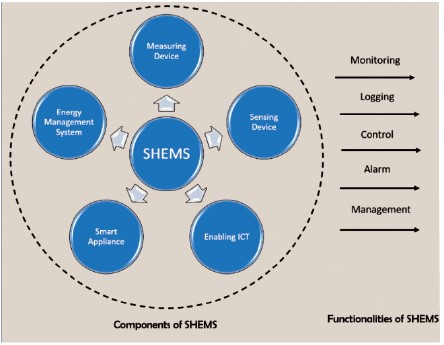
Figure 2. Components and Functionalities of SHEMS
2.3.1 Monitoring
SHEMS must be able to monitor and control various devices and appliances at home. Monitoring gives people access to real-time information about how energy is used. The user can get device information either through the web interface or through the mobile application.
2.3.2 Logging
This is the process of recording information about how much power each device consumes. This feature enables viewing Demand Response (DR) as a price in real time.
2.3.3 Control
In this, the user would be able to control the device manually. Control can be done automatically if the management system has smart scheduling. Also, devices can be controlled from a distance or nearby.
2.3.4 Management
Smart grid devices can provide energy usage data at various ranges. HEMS should be able to handle a lot of data quickly and effectively.
A microcontroller is also called an embedded controller. There are many different types of microcontrollers, including 4-bit, 8-bit, 64-bit, and 128-bit as shown in Figure 3. A microcontroller is a small computer designed to control the functions of embedded systems in office machines, robots, household appliances, cars, and many other devices.

Figure 3. Microcontroller
Figure 4 shows an energy meter which is an electrical device that measures how much electricity is being used by a building, an apartment, or another electrical energy facility. Electricity boards install electricity meters in customers' homes to measure how much electricity the customers use for billing purposes.
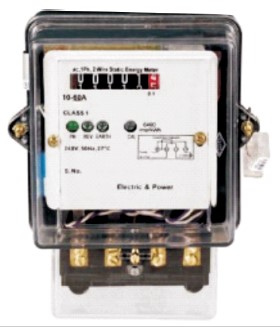
Figure 4. Energy Meter
NodeMCU is an open-source platform based on the ESP8266 that allows for connectivity and data transfer via Wi-Fi as shown in Figure 5. Also, it has some of the most important features of microcontrollers, like generalpurpose input and output (GPIO), pulse-width modulation (PWM), and an Analog-to-Digital Converter (ADC).

Figure 5. NodeMCU
Current Transformer (CT) coils are used to measure electric power in grid stations, control rooms, and powerhouses, to analyze the flow of current in a circuit, and for security. Figure 6 shows the CT coil which is used to measure energy in both homes and industries.
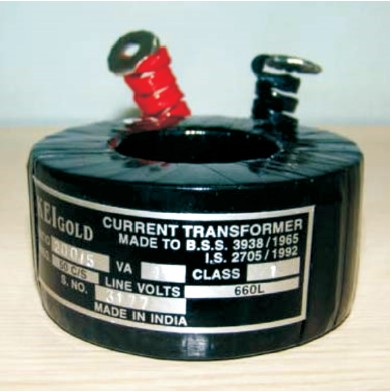
Figure 6. CT Coil
The amount of energy used in a certain amount of time is measured in watt-hours, which are units of energy (e.g., daily, annually). The amount of electricity used is calculated by multiplying each load by the number of hours it runs.
Smart plugs are one of the most affordable and simpleto- use smart home devices as shown in Figure 7. It allows almost any wired appliance in the house with an on/off switch to become a smart one that can be controlled with a tap command.
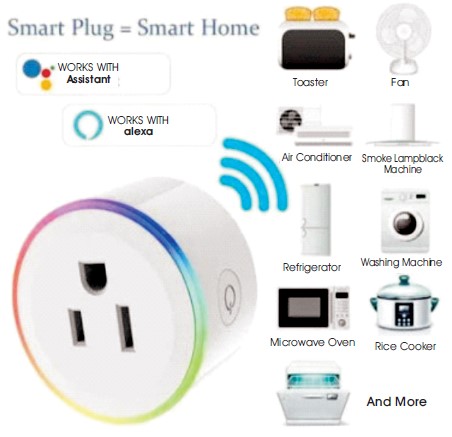
Figure 7. Smart Plug
Figure 8 shows IoT modems which receive wireless data from remote sensors and send it to a different communication format, such as Bluetooth, Transmission Control Protocol (TCP), Serial, RS-485, or another popular communication technology.
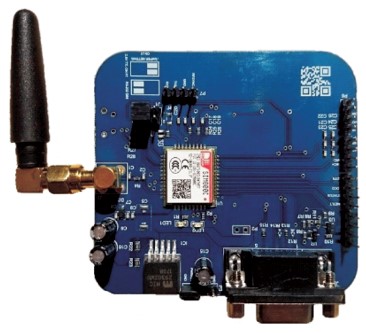
Figure 8. IoT Modem
Relays are used when a circuit needs to be controlled by a separate, low-power signal or when a single signal needs to control more than one circuit as shown in Figure 9.
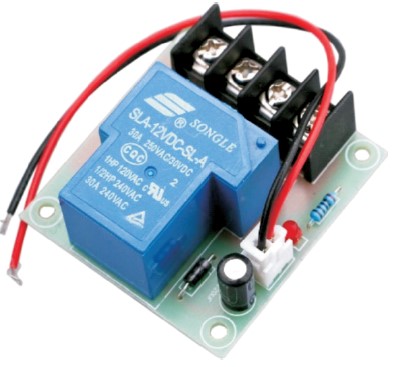
Figure 9. Relay
Figure 10 shows a buzzer, which is defined as a device that produces an audible tone when an external voltage is applied. This output could be a buzzing or beeping sound.
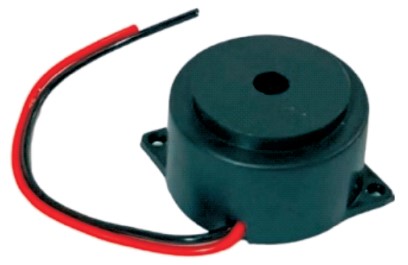
Figure 10. Buzzer
The smart home environment consists of IoT sensors and actuators. This gives various household appliances in a smart home which has ability to understand, make decisions, and change. Smart home systems have been made possible by things like advanced Internet of Things (IoT) sensor technology. Figure 11 shows a prototype of the proposed system. The proposed system has two microcontroller units, A and B. Microcontroller A is used to monitor the input and output power of the CT coil to the load. Microcontroller B controls and monitors the power consumption of each smart device in this system. Ordinary household appliances are also converted into smart devices with a smart plug. Smart home manage resources on the demand side by switching energy consumption during peak hours to reduce electricity bills. The NodeMCU in microcontroller B sends the power consumption data of the load to microcontroller A through the NodeMUC present in microcontroller A. If the energy input received by the CT coil from the energy meter is greater than the energy consumed by the load, then power theft is achieved. This is detected by microcontroller A, which sends an alert message to the mobile device and electricity board via the IoT modem, and the relay is activated and the buzzer warns with an alarm. No action is required if the input and output energy used are equal.
Energy monitoring is an innovative application of the Internet of Things designed to remotely control household appliances. The better option is an IoT-based smart home energy management system. Smart plugs have the ability to monitor and measure the amount of energy used by the electrical devices that are plugged into them. The proposed system monitors energy load consumption via Wi-Fi, and it will assist consumers in avoiding unnecessary use of electricity. It will also detect energy theft if it occurs. This system's main goal is to monitor energy consumption and identify energy theft in an informative manner so that a user can control power management and security threats in the home's energy consumption even when the user is not physically present.